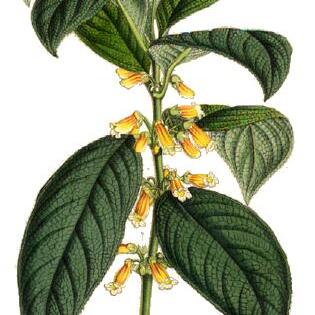Terrestrial, perennial herbs or shrubs with fibrous roots; stems terete or quadrangular, to 5 m tall, often unbranched. Leaves opposite, in equal or un-equal pairs, elliptic, ovate or lanceolate, membranous to coriaceous, the apex acute to acuminate, the base cuneate or rounded, entire to coarsely dentate, the stomata randomly scattered; petioles short or long. Inflorescences axillary, fasciculate, cymose, to subumbellate; peduncles lacking to elongated; bracts absent. Flowers rarely solitary; floral tube very short; calyx lobes united at least at the base, or campanulate, urceolate or cyclindric, 5-toothed or parted, imbricate, rounded to acuminate, entire to serrulate, green or colored; corolla yellow, orange, red, or white, erect or oblique in the calyx, the tube usually cylindric, sometimes spurred or gibbous at the base and sometimes ventricose and contacted at the throat, the limb regular or irregular, 5-lobed, entire; fertile stamens 4, didynamous, included, the filaments broad, adnate to the base of the corolla tube, flattened, usually glabrous, the anthers coherent at first, becoming free, the locules confluent at the apex, the staminode occasionally present; disc annular, usually glabrous, entire, sometimes colored; ovary superior, unilocular with the two parietal placentas ovuliferous only on the inner surface or on both surfaces, the stigma stomatomorphic or bibbed. Fruit a fleshy globose berry, red, orange, or white, exocarp thick, verrucose or smooth; seeds minute, ellipsoid, numerous, reddish brown, striate.
More
Terrestrial or rarely epiphytic, caulescent, erect, rarely scandent herbs or shrubs, without modified stems. Stems rarely branched. Leaves opposite, rarely ternate, equal to unequal in a pair, venation pinnate, foliar nectaries absent. Flowers axillary, rarely solitary, but more usually in few-many fasciculate, epedunculate to long-pedunculate, cymose or subumbellate inflorescences; bracteoles absent; short or long pedicellate. Calyx lobes 5, usually connate at base into a short or long tube; corolla yellow, orange, red, or white, usually cylindric with 5 lobes; stamens included, filaments usually not connate, anthers coherent at first, becoming free, dehiscing by longitudinal slits, thecae parallel to divergent; staminode occasionally developing; disc annular, entire; ovary superior, stigma stomatomorphic to 2-lobed. Fruit a fleshy, indehiscent, red, orange, or white berry.

